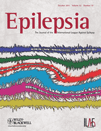Epileptic and nonepileptic features in patients with early onset epileptic encephalopathy and STXBP1 mutations
Summary
Purpose: STXBP1 (MUNC18-1) mutations have been associated with various types of epilepsies, mostly beginning early in life. To refine the phenotype associated with STXBP1 aberrations in early onset epileptic syndromes, we studied this gene in a cohort of patients with early onset epileptic encephalopathy.
Methods: STXBP1 was screened in a multicenter cohort of 52 patients with early onset epilepsy (first seizure observed before the age of 3 months), no cortical malformation on brain magnetic resonance imaging (MRI), and negative metabolic screening. Three groups of patients could be distinguished in this cohort: (1) Ohtahara syndromes (n = 38); (2) early myoclonic encephalopathies (n = 7); and (3) early onset epileptic encephalopathies that did not match any familiar syndrome (n = 7). None of the patients displayed any cortical malformation on brain MRI and all were screened through multiple video–electroencephalography (EEG) recordings for a time period spanning from birth to their sixth postnatal month. Subsequently, patients had standard EEG or video-EEG recordings.
Key Findings: We found five novel STXBP1 mutations in patients for whom video-EEG recordings could be sampled from the beginning of the disease. All patients with a mutation displayed Ohtahara syndrome, since most early seizures could be classified as epileptic spasms and since the silent EEG periods were on average shorter than bursts. However, each patient in addition displayed a particular clinical and EEG feature: In two patients, early seizures were clonic, with very early EEG studies exhibiting relatively low amplitude bursts of activity before progressing into a typical suppression-burst pattern, whereas the three other patients displayed epileptic spasms associated with typical suppression-burst patterns starting from the early recordings. Epilepsy dramatically improved after 6 months and finally disappeared before the end of the first year of life for four patients; the remaining one patient had few seizures until 18 months of age. In parallel, EEG paroxysmal abnormalities disappeared in three patients and decreased in two, giving place to continuous activity with fast rhythms. Each patient displayed frequent nonepileptic movement disorders that could easily be mistaken for epileptic seizures. These movements could be observed as early as the neonatal period and, unlike seizures, persisted during all the follow-up period.
Significance: We confirm that STXBP1 is a major gene to screen in cases of Ohtahara syndrome, since it is mutated in >10% of the Ohtahara patients within our cohort. This gene should particularly be tested in the case of a surprising evolution of the patient condition if epileptic seizures and EEG paroxysmal activity disappear and are replaced by fast rhythms after the end of the first postnatal year.




